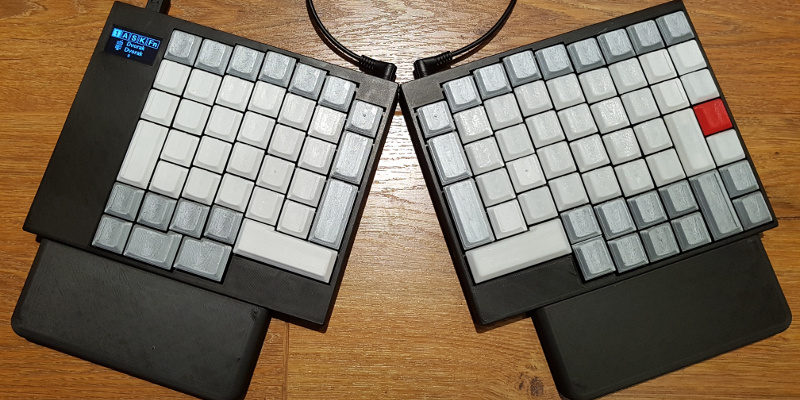In 2011, [Fabio] had been working behind a keyboard for about a decade when he started noticing wrist pain. This is a common long-term injury for people at desk jobs, but rather than buy an ergonomic keyboard he decided that none of the commercial offerings had all of the features he needed. Instead, he set out on a five-year journey to build the perfect ergonomic keyboard.
Part of the problem with other solutions was that no keyboards could be left in Dvorak (a keyboard layout [Fabio] finds improves his typing speed) after rebooting the computer, and Arduino-based solutions would not make themselves available to the computer’s BIOS. Luckily he found the LUFA keyboard library, and then was able to salvage a PCB from another keyboard. From there, he programmed everything on a Teensy microcontroller, added an OLED screen, and soldered it all together (including a set of Cherry MX switches).
Of course, the build wasn’t truly complete until recently, when a custom two-part case was 3D printed. The build quality and attention to detail in this project is impressive, and if you want to roll out your own [Fabio] has made all of the CAD files and software available. Should you wish to incorporate some of his designs into other types of specialized keyboards, there are some ideas floating around that will surely improve your typing or workflow.
















QMK firmware is very popular in the mechanical keyboard community with tons of features, runs on avr processors and has some support for arm boards as well.
http://qmk.fm/
https://github.com/qmk/qmk_firmware
Forgot the Trackpoint, so don’t name it ergonomic.
(This is written on a keyboard w/o trackpoint)
Just because it lacks a feature doesn’t mean it’s not ergonomic. Unless you think its un-ergonomic because it also lacks back support?
http://www.dictionary.com/browse/ergonomic
If you need a touchpoint on a normal computer, you’l be looking at spending an extra ~$100 for that…
https://mechanicalkeyboards.com/shop/index.php?l=product_detail&p=3042
Tex Yoda 2
Problem with TEX Yoda is it isn’t so compelling from an ergonomic standpont.
I have been searching far and wide for a split ortholinear keyboard featuring a trackpoint.
Recently this project came to my attention. It’s all of the above, with a trackpoint on each half: http://eucalyn.hatenadiary.jp/entry/original-keyboard-toc
It’s a build log and not a guide. Also, you’ll probably want to use Google Translate if you don’t know Japanese. My hope is more details will be shared by the author. :)
This looks very ergodoxy…I wonder what he needed that the ergodox or ergodox infinity couldn’t do.
Function keys? Real ones I mean, not a rubbish layer solution.
I very much enjoy the layers solution for function keys and the like. I mostly don’t want to have to move my fingers from the home row, so now I don’t :-)
Of course I appreciate that it’s not for everyone, and not everyone is a touch typist, so moving from the home row doesn’t really affect them.
Um… Hello Splited TypeMatrix http://www.typematrix.com/2030/features.php )
Ergonomic keyboard is not invented yet, though ;) Still waiting, Kinesis is on a right track, but price has to go down to a 50$ from 300$.
In my opinion this keyboard need more keys.
look this https://klawiatura.wordpress.com/
ins some languages (french or japanese) this is extremely keys
Here’s a good site to get started building something similar.
https://www.ergodox.io/
The most expensive thing is the mechanical keyswitches- I would recommend Gaterons, as they’re much less expensive and feel almost the same.
Wait, what do you mean with ‘won’t make themselves available to BIOS’? Modern computers fully support USB keyboards from the BIOS, and any MCU can do USB keyboard can’t they?
?? My keyboard is Dvorak every time I boot. No rocket science behind that, and I didn’t have to buy OR build anything special.
I like it very much.